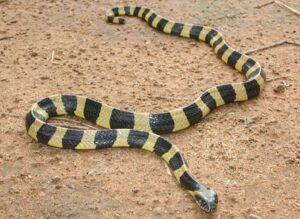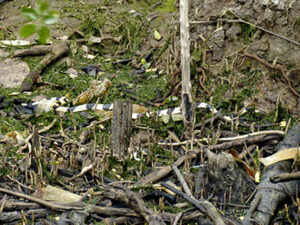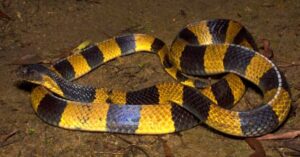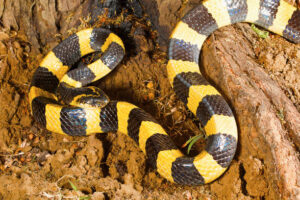
Banded kraits are the largest species of kraits. They are a species of elapid snakes found in the Indian subcontinent. These snakes are venomous but are also shy and avoid attacking humans. They can be identified by the alternating black and yellow bands that cover their entire body.
The word “krait” comes from the Hindi word karait, meaning a type of dark, venomous snake. Its scientific name, Bungarus fasciatus, comes from the Telugu word Bungarus which means “golden,” and the Latin word fasciatus, which means “banded.”
These snakes are nocturnal and are rarely seen. During the day, they are sluggish and stay hidden in grass, pits, or drains. They are more active at night.
They generally do not attempt to bite, even when threatened. However, they become more dangerous at night when they are more active.
Scientific Classifications
- Suborder:Serpentes
- Family:Elapidae
- Genus:Bungarus
- Species:B. fasciatus
Conservation Status
Description
Size
Their average length is 71 inches (180 cm). However, the maximum length of a banded krait recorded so far is 106 inches (270 cm).
Color and Appearance
The body of banded kraits is filled with black and yellow cross bands of equal thickness. Their chin, throat, lips, and the area between their eyes and nostrils are yellow.
They have broad and depressed heads, which cannot be distinguished from its neck. Their body has a cross-sectional area shaped like a triangle. Their tail length is about one-tenth of their body and ends in a nub resembling the snake’s head.
In the middle of their bodies, they have 15 dorsal scale rows as well as a series of undivided sub-caudal scutes running throughout. There are 23-39 hexagonal and strongly enlarged middorsal rows of scales, which are as broad as long, sometimes even broader. Their anal plate is undivided, and the end of their tail is blunt. They have 200-234 ventrals, with a distinct vertebral ridge down the back formed by the neural processes of the vertebrae.
Are They Dangerous to Humans
The venom of a banded krait mainly contains neurotoxins and has an LD50 value of 1.289 mg/kg IV, 1.55 mg/kg IP, and 2.4-3.6 mg/kg SC. The average quantity of venom delivered is 20-114 mg.
Their bite symptoms include diarrhea, dizziness, vomiting, and abdominal pain. It can also cause kidney and respiratory failure, which may lead to death. Today, polyvalent antivenoms against their venom are available in India and Indonesia.
Banded Krait at a Glance
Distribution
These snakes are found in the Indo-Chinese sub-region, Southern China, the Malay Peninsula, and the Indonesian archipelago. They are also prevalent in the Indian subcontinent.
In India, they mainly occur in eastern states like West Bengal, Odisha, Assam, Mizoram, Manipur, and Tripura. They are not very common in western India nowadays but have been recorded in Andhra Pradesh, Madhya Pradesh, Bihar, Jharkhand, Maharashtra, Karnataka, and Chhattisgarh. Outside India, these snakes live in countries like Nepal, Bangladesh, Cambodia, Myanmar, Laos, Thailand, Malaysia, Singapore, and the Indonesian Islands of Borneo.
Habitat
Mostly these snakes live near human settlements like villages but can be seen over diverse habitats. Banded kraits appear to prefer open areas like the countryside, inhabiting rodent holes and termite mounds close to a water source.
Lifespan
Their exact lifespan is unknown, but like other kraits, they are estimated to live up to 20 years.
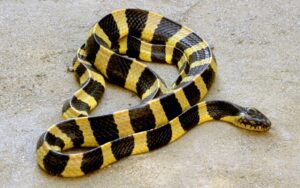
Predators
Sea birds, sharks, and some bony fishes are the predators of banded kraits.
When harassed, they hide their heads under their coils. Predators mistakenly attack the tail, mistaking it for the snake’s head. This leaves them exposed and vulnerable to a counter-attack from the snake.
Diet
Banded kraits mainly feed on snakes like the rat snake, the Indo-Chinese rat snake, the sunbeam snake, the rainbow water snake, the chequered keelback, the buff-striped keelback, the cat snake, the Russell’s viper, the common krait, and the red-tailed pipe snake. They can also eat fish, frogs, snake eggs, and skinks. They first render the prey inactive with their venom and then swallow it head first.
Reproduction
Oviparous by nature, female banded kraits can lay around 4-14 eggs in one litter and guard them until they hatch. The average length of its hatchlings is 298-311 mm. At the age of three, the juveniles become sexually mature at an approximate length of 914 mm.
Similar Species
Yellow Barred Wolf Snake
It has black and yellow banding in the upper half of its body, similar to banded snakes. These snakes are small and harmless.
Mangrove Cat Snake
It is black with thin yellow bands. However, their bands are narrower and do not cover their entire body like in kraits.
King Cobra
Juvenile king cobras look like banded kraits with black and yellow bands.
Malayan Krait
They have similar patterns on their body as in banded kraits, but their bands are black and white instead of black and yellow.
Common Krait
These snakes are also banded, with black and white bands instead of black and yellow bands like the banded kraits.
Many Banded Krait
They are more defensive than banded kraits. They mostly eat fish, whereas banded kraits feed primarily on other snakes.
White Banded Wolf Snake
They have broad and flat heads. Unlike banded kraits, they do not have large hexagonal vertebral scales along its back.
Source
istockphoto.com, blogspot.com, natureweb.net, manoramaonline.com

